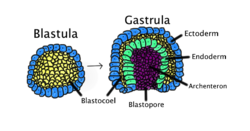Dorsal lip
| Gastrulation | |
|---|---|

Gastrulation occurs when a blastula, made up of one layer, folds inward and enlarges to create a gastrula. This diagram is color-coded: ectoderm, blue; endoderm, green; blastocoel (the yolk sack), yellow; and archenteron (the gut), purple.
|
|
|
Anatomical terminology
[]
|
Gastrulation is a phase early in the embryonic development of most animals, during which the single-layered blastula is reorganized into a multilayered structure known as the gastrula. Before gastrulation, the embryo is a continuous epithelial sheet of cells; by the end of gastrulation, the embryo has begun differentiation to establish distinct cell lineages, set up the basic axes of the body (e.g. dorsal-ventral, anterior-posterior), and internalized one or more cell types including the prospective gut.
In triploblastic organisms the gastrula is trilaminar ("three-layered"). These three germ layers are known as the ectoderm, mesoderm, and endoderm. In diploblastic organisms, such as Cnidaria and Ctenophora, the gastrula has only ectoderm and endoderm.
Gastrulation takes place after cleavage and the formation of the blastula. Gastrulation is followed by organogenesis, when individual organs develop within the newly formed germ layers. Each layer gives rise to specific tissues and organs in the developing embryo. The ectoderm gives rise to epidermis, the nervous system, and to the neural crest in vertebrates. The endoderm gives rise to the epithelium of the digestive system and respiratory system, and organs associated with the digestive system, such as the liver and pancreas. The mesoderm gives rise to many cell types such as muscle, bone, and connective tissue. In vertebrates, mesoderm derivatives include the , the heart, blood and blood vessels, the cartilage of the ribs and vertebrae, and the dermis. Following gastrulation, cells in the body are either organized into sheets of connected cells (as in epithelia), or as a mesh of isolated cells, such as mesenchyme.
...
Wikipedia
